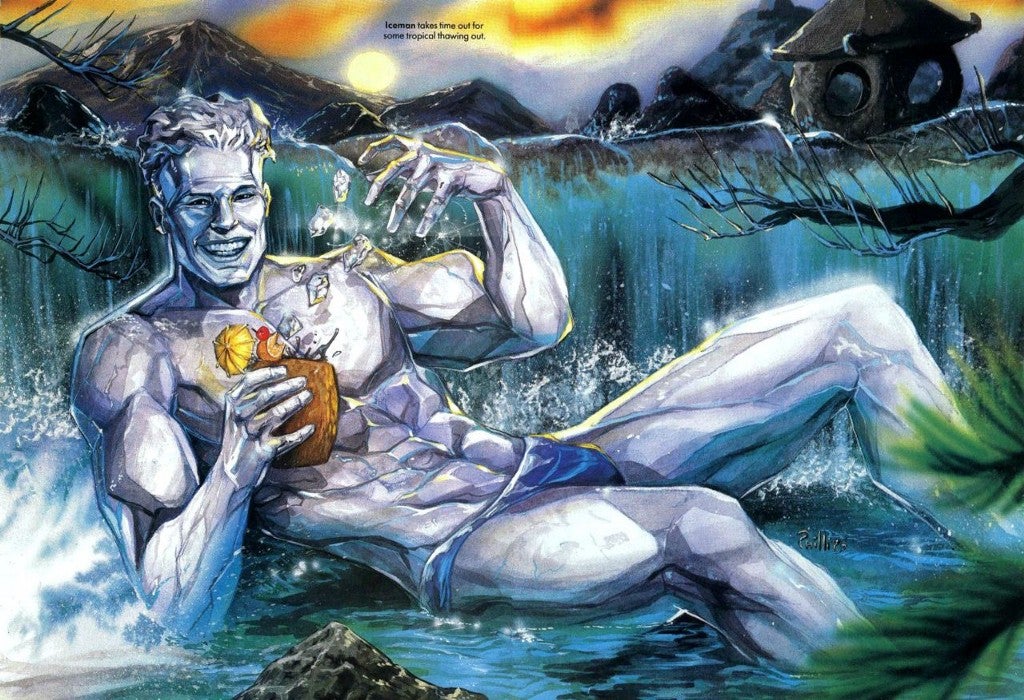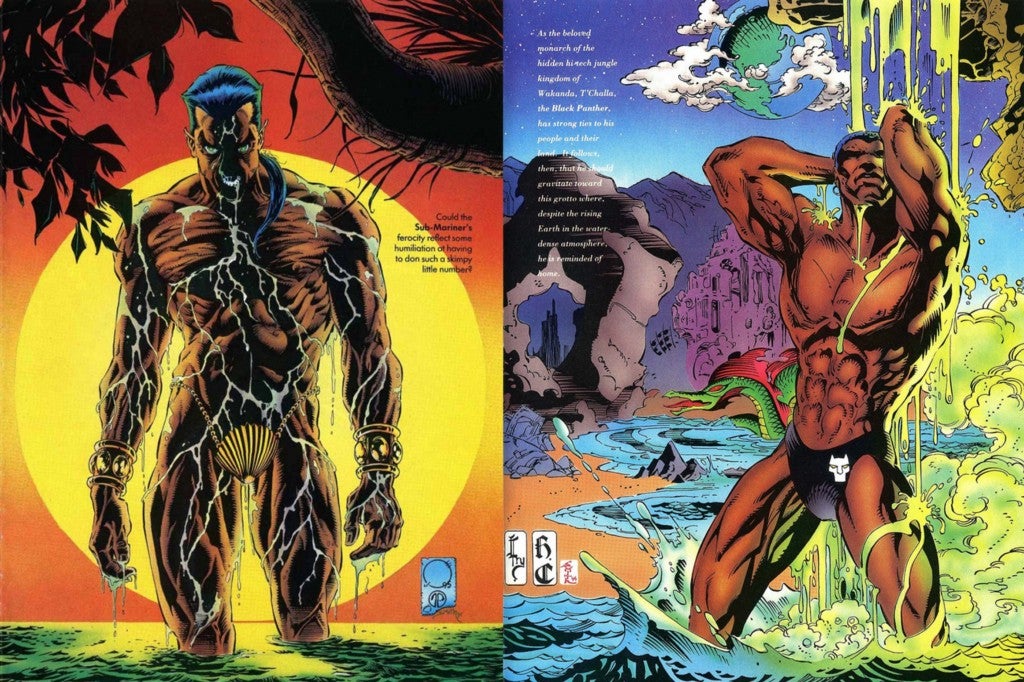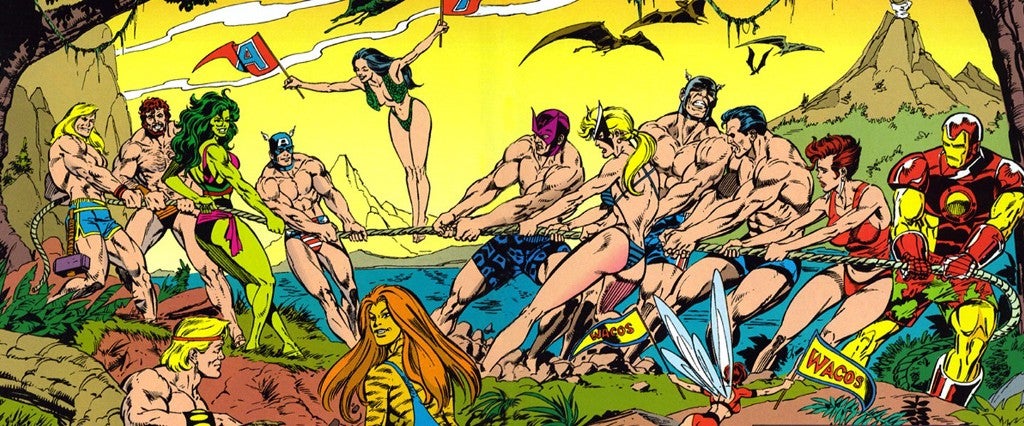Full disclosure: I’m a comics nerd. I’m also a big fan of oral histories. With this in mind — and working at a site whose mission is to investigate evolving masculinity and sexuality, occasionally through a pop culture lens — it seemed a no-brainer to mash it all together in one glorious article: The Oral History of Marvel’s Swimsuit Editions.

That’s a great idea, right? The entire story of the so-bad-they’re-good, cheesecake-stuffed comic books published during the mid-1990s, as told by the people who made them. Why did the famed comics company decide to put out whole issues containing pictures of their most popular superheroes in thong bikinis? How did they decide who to feature, and what they’d wear? Who wrote those amazingly awful blurbs for each pic? Who decided the Punisher needed a set of skull-themed Speedos?
We had so many questions.
But tragically, we got so few answers.
Now, I’ll relate the sad story of why.

It started out well enough: I found a writer with solid connections to the comics industry (a published comics writer and artist, in fact) and told him what I wanted. He was stoked: This was late March — he’d have it to me by early May, he promised.
By late April, we still had nothing. Conventions were a problem, publicists and agents told us. Chicago’s C2E2 was eating up everyone’s time, and with San Diego Comic Con just a couple short months away, finding time for talent to speak was getting harder with each passing day. At this point, my Spidey-sense began tingling. Convention season traditionally meant a glut of famed comic artists and writers being paraded out for interviews — the fact no one was biting was troubling.
By mid-May — around the time we had originally planned to publish it — my fears were justified: The writer threw in the towel and admitted, frustrated, that it was best I reassign the piece. No one wanted to talk about it, he told me: Unlike some other major comics milestones of the 1990s, the Swimsuit Editions weren’t works that creators were terribly proud of.

Fond reminiscence, it seemed, was entirely off the table.
Still, I was determined to have my oral history, so I found another writer, this time one with even deeper, more friendly connections to the industry, particularly Marvel. Things began looking up almost immediately: Interviews were scored with former Marvel editor-in-chief Tom DeFalco and X-Menwriter supreme Chris Claremont, titans of the industry and two of the most influential voices in comics at the time. Neither of them had anything particularly nice to say about the Swimsuit Issues, but still, I held out hope.
Legendary artists George Perez and John Romita Jr. soon gave their takes on the issues and more interviews, the writer assured me, had also been arranged and conducted, and needed just to be transcribed.
It was finally coming together.
Then, in early June: Disaster. The writer’s laptop — with all the recorded interviews — was stolen from his car. None had yet been transcribed.
The writer valiantly attempted to try again, but largely struck out. Perez had a stroke shortly after the first phone call, and was unable to complete a second. Other creators, after some reflection, decided they weren’t willing to speak about the infamous issues after all, with multiple writers and artists admitting, off the record, that they simply didn’t want to be associated with them. One went so far as to laugh and hang up the phone when initially asked for an interview.

By late September, it was clear that we had nothing close to a comprehensive oral history. Claremont and DeFalco were kind enough to weigh in once more, but their discomfort with the subject matter was palpable, meaning any chance of a fun, nostalgic romp was dead in the water.
“Right from the beginning, the magazine was problematic and plagued by the inherent disadvantage female characters face, always,” Claremont told us. “We were trying to tell engaging stories in the comics. Meanwhile, they were slapping this thing [together] at the last minute.”
While not quite as critical of the project as Claremont, DeFalco was less than enthusiastic. “Something like the Marvel Swimsuit Edition probably wouldn’t happen today,” he admitted. “The world was very different in those days. Marvel Comics basically lived or died on how would the comic books were doing: We had a small licensing program. We had an animation studio that was constantly struggling. We couldn’t give away our movie licenses. We lived on the publishing. The idea of having a swimsuit issue kept coming up because in those days, the Sport Illustrated Swimsuit Issue was one of the hottest selling magazines each year, so we decided to have a Swimsuit Issue, too.”
Despite being a clear attempt at a money grab, DeFalco felt that, if nothing else, the male and female characters in the specials received equal treatment. “Unlike other Swimsuit Issues, we had both male and female models. One of the guys came in and was like, ‘We should have the guys in speedos if the women have to wear bikinis!’ At the time, that was very sexualized for a male hero. We did break a lot of walls in terms of sexualizing some of the male characters. Comic books are always accused of sexualizing women and idealizing women, but the truth is we sexualized everybody.”
For Claremont, one of the biggest failings of the project was that they didn’t tell any kind of story, giving them even less justification for existing. “If I had a choice of how to portray the Swimsuit Issue, my instinct would be to showcase the characters and occasionally catch the readers by surprise [with skin]. That would be a way of telling the reader that it isn’t just a sequence of gratuitous images, there’s something here. If you get this book, you’re gonna learn some neat stuff about the characters, so you’ll have to buy it even if you don’t want to look at swimsuits.”
Alas, as anyone who’s read them knows, this isn’t what happened.

Eventually, to my immense shame and sadness, the piece I had eagerly pitched way back in February was thrown on the scrap heap of abandoned story ideas in early October. The Swimsuit Issues had failed to save Marvel (who filed for bankruptcy in 1996, bailed out only by a slew of suddenly highly profitable movie deals), and they’d failed to bring together the top talent of the time to minutely discuss their awesome terribleness.

It was all over — the everlovin’ end, true believer.
With the piece clearly a no-go, I asked the writer to mail me the old Marvel Swimsuit Issues I’d had him buy off eBay to art the story. If nothing else, I thought, I’d be able to expense a fun memento of the project.
The package arrived two days later and was promptly stolen from the doorway of our building.
The curse of the Marvel Swimsuit Issues is still, it seems, a long way from being lifted.

